In coming to understand the phenomenon of change in education, noted historian Larry Cuban (in his How Teachers Taught: Constancy and Change in American Classrooms, 1890-1990) used the metaphor of the hurricane to describe the layers of activity attendant to educational innovation:
Hurricane winds sweep across the sea tossing up twenty-foot waves; a fathom below the surface turbulent waters swirl while on the ocean floor there is unruffled calm . . . . [Cuban] compared that hurricane to any newly trumpeted curriculum theory. Professional books, for example, echo pro and con arguments on a new theory. Letters to editors and sharp rebuttals add to the flurry. Books are written and reputations made. Conferences host both skeptics and advocates. Professors of education teach the new wisdom to their students. Yet most publishers continue producing texts untouched by that theory, and most teachers use methods unmarked by controversy, slogans, journal articles, or convention programs.1
In searching for evidence of change in music teacher education, I found Cuban’s three levels of activity to be useful organizers. Level 3, the hurricane tossing up twenty-foot waves, consists of large-scale events in society and general education. Level 2, a fathom below the ocean’s surface, refers to smaller-scale events in music and music education. Level 1, on the ocean floor, is evidence of practice in both music teacher education as well as music teaching practice viewed as a reflection of preparation (although with a large margin for distortion). I used evidence from the area of general music as the barometer in this examination, as it seems to be the area of music teaching specialization most susceptible to change (as Cuban found with elementary teaching in general) and for which there is the greatest (though still quite limited) amount of information. The performance traditions in both K-12 classrooms and collegiate settings have remained relatively stable and robust.
Mapping the Levels of Activity2
The 1950s & 1960s
Level 3: Societal & General Education
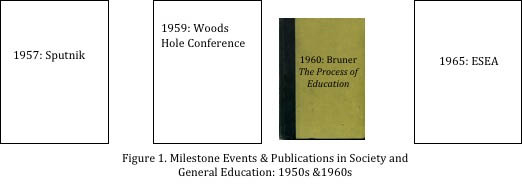
The year 1957 is a propitious time to start this analysis. Following the Soviet Union’s launch of the satellite Sputnik, attention to our educational system as a key factor in global competitiveness, particularly technological, dramatically increased. Events in the next two decades lead Roger Rideout to declare these “Emboldened Days” for education in general and music education in particular.3 The Woods Hole Conference in 1959 devoted to the improvement of science education and the subsequent publication of Jerome Bruner’s The Process of Education were educational launching pads for thinking and curriculum work in most school subjects. The notions of shaping instruction according to the structure of the discipline and encountering and reencountering central concepts in a spiral fashion in increasingly sophisticated ways were reflected in a spate of new instructional materials. The passage in 1965 of the Elementary and Secondary Education Act brought unprecedented federal resources to bear on bringing ideas to reality, with at least twenty-foot waves and some movement below the ocean’s surface.
Level 2: Music & Music Education
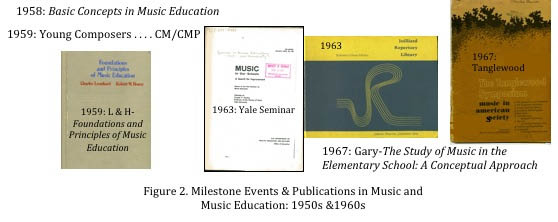
Basic Concepts in Music Education, edited by Nelson Henry, and Foundations and Principles of Music Education by Charles Leonhard and Robert House were milestone publications for the profession, as they helped to set the stage for establishing a philosophical base for music education thinking and practice. A more direct impact on professional practice was made through the Young Composers Project begun in 1959 and the related Contemporary Music Project launched in 1963, the legacy of which today is captured by the term Comprehensive Musicianship.
Recommendations from the Yale Seminar in 1963 were primarily directed at the quality of music used in school music programs and dissatisfaction with what was considered to be a narrow definition of what it means to be musically educated. The Juilliard Repertory Project was a direct outgrowth of the seminar but, as Rideout has noted, “no bad Hollywood film ever went to the video store shelves faster than [it] went to library shelves. Few of the works had performing editions usable by students. This turned off ensemble directors and the implication that general music study might solely be a listening activity . . . was incompatible with music making as active ‘doing.”’4 The National Association for Music Education (MENC) organized its own version of the Yale Seminar, The Tanglewood Symposium, and it echoed some of the sentiments expressed in the former document, but also emphasized the role of American music in the curriculum, particularly jazz and improvisation. The MENC publication, The Study of Music in the Elementary School: A Conceptual Approach, illustrates the move in professional thinking from an activity-based curriculum to one emphasizing structural features within the music itself.
Level 1: Evidence of Music Education Practice
In her “Fifty Years of Elementary General Music: One Person’s Perspective,” Eunice Boardman noted that, from the late 1940s through the 1950s, there was a move from the songbook approach to the five-fold curriculum in which music was experienced through not only singing but playing, creating, listening and reading. A renewed interest in child development, learning theory, and philosophy precipitated a broadening of schools of thought and choices. Music teaching methodologies imported from abroad also added to the menu available: Orff, Dalcroze, Kodály, Suzuki. For a closer look at what most likely constituted music teaching practice in the classroom, images from fifth-grade level basal series textbooks have been selected to track changes over time. In addition to series’ titles and sample images, predominant instructional characteristics are listed in bullet form.
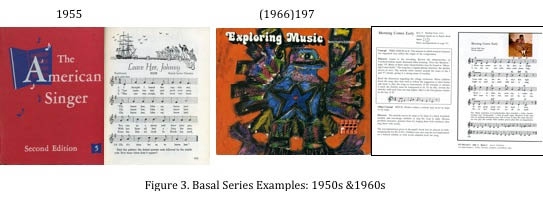
1955: The American Singer
(1966)1975 Exploring Music
The 1970s
Level 3: Societal & General Education
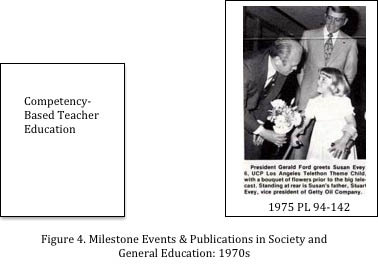
During the decade of the 1970s, the prevailing approach to teacher education in general was Competency-Based Teacher Education or CBTE. Undergirding this movement was the idea or belief that specific teacher behaviors could be identified (and learned) that were directly related to student learning. The corollary to this is the process-product research tradition in favor during this time. Another major wind blowing during this decade was prompted by the passage of Public Law 94-142, the Education of All Handicapped Children Act (now known as IDEA), which mandated that all children with disabilities be given a free public education. This had obvious implications for how teachers were supposed to be prepared to serve an increasingly diverse school population.
Level 2: Music & Music Education
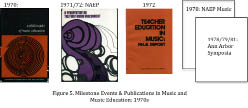
Related to some degree to the 1959 work of Leonhard and House was the 1970 publication of A Philosophy of Music Education by Bennett Reimer, which provided the platform for the idea of Music Education as Aesthetic Education (MEAE) in our thinking, practice and, to a certain extent, instructional materials (most notably those from Silver Burdett). The music education profession was also called to some sort of accountability–due in part to the large expenditures of federal money of the 1960s–through its inclusion in the National Assessment of Educational Progress in 1972 and again in 1978. Also created during this decade was a report from MENC on music teacher education that reflected the competency-based approach in vogue for teacher education at large. In the Preface to that document, Frances Andrews—then MENC President—wrote:
When the Commission was beginning its work I suggested, in a conversation with a colleague, that it might be good if all present teacher education curriculums were irretrievably sunk in the deepest part of the Pacific. We would then, it seemed to me, be forced to go about devising a curriculum that would meet the needs of present day use. My colleague smiled and said, “You forget—some people would never give up diving for it.”5
Level 1: Evidence of Practice
As part of its work, MENC’s Commission on Teacher Education in Music conducted a survey to identify “innovative and exemplary pre-service curriculums” which are described in the 1972 report.6 Twenty-two programs were ultimately selected and five themes or trends emerged. Findings included the following observations.
The most conspicuous trend is the movement away from compartmentalization of theory/musicianship and music history/literature aspects of the program. It is quite evident that the Contemporary Music Project has played a significant role in this respect. Six of the schools offer a sequence of courses in comprehensive musicianship ranging in length from two to four years. Two schools have pilot projects under the Manhattanville Music Curriculum Program, and another offers a comprehensive music major that supplements the development of broad musical competencies with instruction in the other arts and humanities.
A second trend is the transformation of methods courses into field workshop experiences. Six institutions require extensive observation and participation by music education students in public school classrooms. Some of these opportunities begin as early as the freshman year and are used to admit and screen music education majors. . . .
Inclusion in the curriculum of music representing all periods, styles, forms and cultures [is another trend]. There is also evident interest in creativity, including the ability to improvise and write in various styles.
Finally, individualization of the curriculum appeared to be a goal of five institutions [which included student choice within the program along with changes in the academic calendar allowing for greater choice].7
In his 1974 analysis for CMS of changes to the music teacher education program over the past decade, Charles Hoffer echoed the trends identified by the MENC Commission and also noted that methods courses have become a bit “more substantive”:
In the past there was a tendency for methods courses to concentrate on the superficial aspects of teaching–ventilation, seating arrangements, and purchasing procedures–or to be highly activity-oriented, with sometimes little intellectual involvement. Although these types of methods classes have certainly not disappeared, many such courses now involve the students in basic psychological, philosophical, educational, and sociological principles that have application to music teaching.8
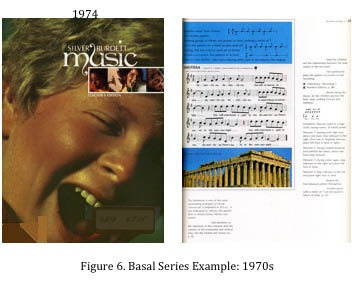
1974 Silver Burdett Music
- More authentic world music with accompanying dance
- Aesthetic education: expressive quialities—7/8 and pattern in architecture
The 1980s
Level 3: Societal & General Education
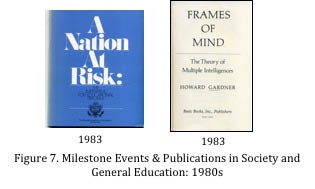
The biggest storm of the 1980s was the well-known publication, A Nation at Risk (National Commission on Excellence in Education, 1983), which fueled Sputnik-like attention to our educational system, but this time in terms of our economic competitiveness. Howard Gardner’s work, beginning with his book, Frames of Mind: The Theory of Multiple Intelligences (1983) provided a very different view of what it means to be truly educated as compared to the narrow definition implied by A Nation at Risk.
Level 2: Music & Music Education

In his 1981 contribution to the College Music Symposium, “The Fragmentation of the Music Education Profession,” Michael Mark sounded an alarm with respect to the growing diversity of approaches to music teaching and the resulting balkanization of professional conversation and practice. The same menu of choices cited by Boardman and encouraged by the Yale and Tanglewood meetings had become “camps”–which he termed “widely divided loyalties—and served to blur an overarching mission for the music education enterprise. In part, this was due to our philosophical immaturity but due as well to economic conditions that were shrinking support for our school and college music programs and, subsequently, the collective vision that we could entertain for ourselves whilst under siege.
In 1987, fifteen years after its first publication calling for change in music teacher education, MENC issued a new document entitled Music Teacher Education: Partnership and Process. This new model for programs emphasized the coordinated contributions by school music teachers and college music and music education faculty to the process of helping prospective teachers prepare to meet the music education needs of students in an ever changing society. In addition to the knowledge and skills that should continue to be a central part of the music teacher curriculum, writers of the document listed the following challenges to be faced by teachers in the future:
- The problems and processes of effective instruction and the relationship of musical content to good instructional design;
- The variety of learners in music classrooms and how to accommodate their unique learning needs;
- The role of music and related arts as an integral part of the total educational experience;
- The use of creative endeavors (composition, improvisation) as critical skills in music;
- The diversity of music and musical styles that reflect the rich and varied cultures of our times;
- The use and functions of music in society and the influences of music on human behavior;
- The role of performing as it relates to adapting musical experiences and knowledge to emerging patterns of use.9
Level 1: Evidence of Practice
One of the few portraits of actual music teaching practice that I was able to find were case studies of arts offerings in “ordinary” elementary schools that were undertaken in the late 1980s (Custom and Cherishing: The Arts in Elementary Schools written by Robert Stake, Liora Bresler and Linda Mabry and sponsored by the National Arts Education Research Center). Specifically in elementary music teaching, the researchers documented a wide variety of approaches, including singing songs, guided listening in preparation for attending a live performance, a focus on socialization (“behavior in class and at music programs”), music instruction as an add-on (a Suzuki program in the Chicago schools in which no arts specialists are employed), and a program infused with preparation for competitions and contests in Texas. In most cases, classes in music were held once a week for about forty minutes. Based on observations across the arts and at all levels, they concluded that
The paths of the arts in the schools are many. Curriculum organizers in the arts are fewer and less canonized than those in other subject matters. Their agents (specialists and classroom teachers and others) are extraordinarily diverse in training, commitment and aspiration. Contexts, too, are widely different: from classrooms, studios, school auditoriums, to museums, opera and theatre halls. With few demands to standardize or to increase test scores, productivity and cognitive skills, teachers are left to draw on their own resources, personal beliefs and visions . . . .10
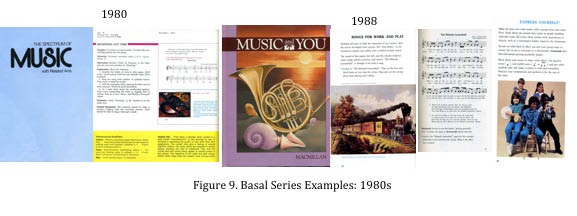
1980 The Spectrum of Music with Related Arts
1988 Music and You
• Lessons are themed: trains
The 1990s
Level 3: Societal & General Education
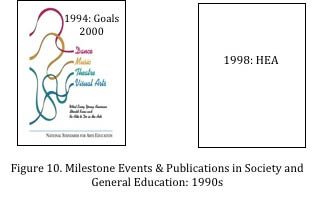
Whereas once the various levels of governmental relationship to schools was federal interest, state influence and local control, the tide turned with the passage of Goals 2000, a federal initiative launched in 1990 intended to create national educational goals. This federal interest turned to involvement and even control was extended to postsecondary education through the Higher Education Act of 1998.
Level 2: Music & Music Education
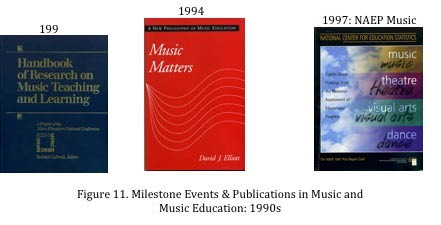
A new level of maturity in the scholarship of the music education profession was reflected in our first Handbook of Research on Music Teaching and Learning published in 1992 and edited by Richard Colwell. This maturing was also evident in a second major philosophical point of view in David Elliott’s Music Matters (1994), in which he argues that the worth of an education in music resides in the doing of music (as contrasted with the earlier MEAE which Reimer has expanded upon in two later versions of that publication).
Level 1: Evidence of Practice
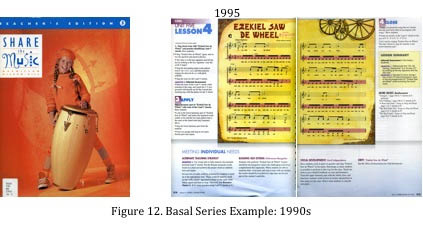
1995 Share the Music
The New Millenium 2000—
Level 3: Societal & General Education
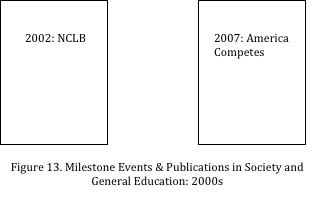
We are living with the societal and general education “events” of this decade with little need for explanation. “No Child Left Behind” (a drastically different piece of legislation than its 1965 version in the ESEA) has imposed curricular constraints on school and we now have “America Competes” (which interestingly is in part a response to recommendations made by the National Academies’ “Rising Above the National Storm”) which focuses attention and dollars on the STEM disciplines (and M does not stand for Music).
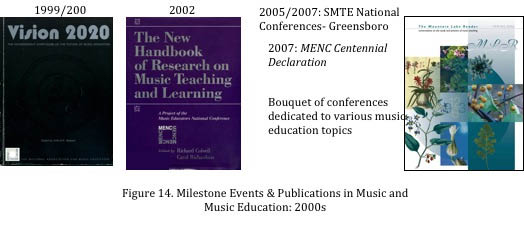
The turn of the century has been accompanied by a bouquet of reflective events in music education with an attendant focus on the future. Vision 2020 reaffirmed some of the recommendations made in the Tanglewood Declaration with additions reflecting changes in society and professional thinking over the ensuing thirty-two years. For one of its one-hundredth birthday celebrations, MENC held a Centennial Congress this past June that resulted in a declaration similar to that of Vision 2020. It begins:
We are in agreement that the basic ideals long expressed by the music education profession and other education professionals are still current: It is the right of every child to receive a balanced, comprehensive, sequential music education taught by qualified music teachers.
A healthy society requires musically fulfilled people. The primary purpose of education is not to create a workforce; it is to improve the quality of life for individuals and for society. Although music education has been valued throughout history for its unique contributions, it is not yet universal in American schools. Serious problems persist, including inequality of access, uneven quality of programs, and insufficient valuing of music as a part of the curriculum. As a result, music is often pushed to the periphery of the school experience. In this centennial year of 2007, we reaffirm our longstanding ideals in a challenging context that calls for directed action in curriculum, assessment, research, teacher education, advocacy, and building alliances.11
Level 1: Evidence of Practice
In the late 1980s, Ken Howey and Nancy Zimpher undertook case studies of six different programs of pre-service teacher education: two at Big Ten research-oriented institutions; three at “relatively large state-supported institutions with a history of preparing teachers”; and one at a liberal arts college. Knowing faculty at most of these institutions, I speculated that follow up on these stories might provide some indication of current practice and, maybe, change over the past twenty years.
All four of the six programs about which I was able to acquire current information reflect in varying degrees some of the features of the innovative programs cited in the 1972 MENC document describing innovative and exemplary programs. Field experiences are common fare. Diversity in musical repertory has also now become the norm, along with opportunities for first-hand study of other cultures in some programs. The mandate of PL 94-142 of 1975 (IDEA) echoed in the recommendation of the 1987 MENC Partnership and Process document is reflected in each program with required coursework in special education to address “the variety of learners in music classrooms and how to accommodate their unique learning needs.”12 And, there is evidence in some places of an emphasis on “creative endeavors (composition, improvisation) as critical skills in music.”13 Each program, however, has features that are unique to its history, its place, and its people.
The chapter on Luther College—the liberal arts institution in this collection—was entitled “Teacher Education and Liberal Study in a Conservative Setting: Paradox and Promise.” Dennis Darling, music faculty member at Luther, reported that the liberal arts tradition is alive and well in Decorah. At the heart of all programs is Paideia, a common core of required courses and experiences in recognition “that life and community depend on centuries of shared wisdom.”14 For most programs of professional preparation, there is some tension with the liberal arts. As one student noted:
I think one problem I’m fighting here is that because it is a liberal arts college, I have to take all of these other classes. I can’t take the classes, like the methods classes, when I want to. There are so many other requirements, you can’t take these other courses. There really isn’t time.15
Darling (personal communication) observed that the addition of requirements in the area of music education (as mandated by the state) exacerbates an already crowded curricular landscape. But he also noted that “departmental walls have become more porous” and small victories have been won in the assignment of course locations, e.g., the Paideia capstone for education students. “Making Decisions in U.S. Schools” and several education courses, for instance, are counted as social sciences within the liberal arts requirement.
Teacher education at the University of Toledo—one of the relatively large state-supported institutions–was designed according to the tenets of Competency-Based Teacher Education (CBTE) with discrete modules, a prescribed developmental sequence, cohort groups and adherence to the principles of mastery learning. Ed Duling (personal communication) believes that CBTE still characterizes the program but that these competencies are now stated within the frameworks of the National Standards, PRAXIS domains, Ohio Department of Education requirements, and NCATE accreditation standards and are nested within specific coursework.
One of the two Big Ten schools—Indiana University—was in the process of moving toward the integration of major technological innovations through the establishment of The Center for Excellence in Education which is now housed in the Wright Education Building. Brent Gault (personal communication) reported that distance education, on line courses, video conferences, and live feeds from field locations are common fare in their teacher education programs and are utilized by some music education students who are required to take two courses in the College of Education. Current programmatic trends relate largely to making the entire statewide system in Indiana better aligned with a common curriculum in order to facilitate transfers and providing post baccalaureate options for teacher licensure in recognition of market forces.
The other Big Ten school—Michigan State University—was described by Kenneth Howey and Nancy Zimpher as having “conceptually coherent alternative programs”16: academic learning, heterogeneous classrooms, learning communities, and multiple perspectives. Cynthia Taggart (personal communication) reported that all the values embedded in each of these four programs have been combined into one. The goal is to “help students learn to teach worthy subject matter to diverse students, with an eye toward social justice.”17 All education students (including music education students) complete the same professional course sequence (five courses) and belong to cohort groups. Themes within this coursework include reflection, learning communities, and teaching as inquiry. Perhaps unique to the music and music education experiences of students at MSU are the emphases on music teacher (as opposed to band or choir director), lifelong learning and creativity.
Providing something of a mirror on teacher preparation by describing practice, Sandy Stauffer recounts her experience of music in the schools with a story entitled “Three Days in Mississippi.” In a three-day period of providing teacher workshops in three locations along a 400-mile stretch of highway during which school children performed, she encountered three quite distinct scenarios.
In Jackson:
Their teacher begins an accompaniment on an electric keyboard, and the students burst into a jazz-style song about pride and respect, complete with a tag ending. The next half hour is a blur of blues, popular, and gospel numbers, all performed with tremendous enthusiasm. Recorder descants and bass lines on Orff instruments, percussion accompaniments and movement, student piano solos and a guest artist performance are woven into the presentation.
In Oxford:
A fifth-grade class [sang] and [played] their favorite songs from their seats at a keyboard lab. After the keyboard demonstration, the children jumped to their feet for a rendition of a two-part popular song, including solfa syllables and hand signs.
In Long Beach:
Five classes of fourth-grade students . . .each group made distinct by a bold colored t-shirt–lined up in a church sanctuary to perform . . . . Their half-hour concert of unison, two-part and three-part choral works included folk songs, popular songs, and contemporary works.18
And these programs are unique to each place with it own history, people–teachers and students, resources, values and visions.
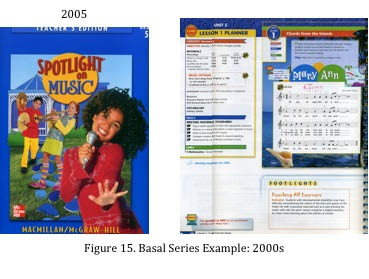
2005 Spotlight on Music
Sense Making
In his contribution to a symposium devoted to Arts Education in the 20th Century, Charles Dorn observed that “anyone claiming to know what art education has been all about in American schools over this past century is probably faking it.”19 Nevertheless, there have been some attempts to frame our history from a variety of perspectives to help us understand our current state of affairs as well as the road that lead us here. In the general field of teacher education, Marilyn Cochran-Smith identifies three changing orientations to teacher education. The first period, from the late 1950s to the early 1980s, she terms “Teacher Education as a Training Problem,” that is, preparation of teachers was viewed as a process in which teachers-to-be were taught the skills thought to characterize effective teaching. This conception of teaching is based primarily on the linear, technical model with roots squarely in the tradition of the behaviorists. The period from the early 1980s through the early 2000s she characterizes as “Teacher Education as a Learning Problem.” In this orientation, the focus is on teachers as professionals who are thinking beings, have attitudes, values and beliefs of their own, and who have agency in their learning and teaching. Also a part of this approach is a faith in the existence of a professional knowledge base. The current orientation to the enterprise she frames as “Teacher Education as a Policy Problem.” She argues:
Constructing teacher education as a policy problem means identifying both institution-level policies (such as entrance and course requirements or 4- and 5-year program structures) and state or larger scale policies and practices (such as state teacher tests, allowable entry routes, licensure regulations) that are presumably warranted by empirical evidence demonstrating positive effects on desired outcomes. At the local level, for example, practitioners are striving to develop evidence about the effect of teacher candidates’ performance on pupils’ learning. At state and larger levels, policy makers are seeking empirical studies, preferably experimental studies or correlational studies with sophisticated statistical analyses, that indicate which aspects of teacher preparation do and do not have a systematic and positive effect on pupils’ learning, particularly scores on standardized tests.20
In Boardman’s retrospective on 50 years of teaching general music, she notes the progression of orientations to be from a song approach to the five-fold curriculum to conceptually-based teaching. From the standpoint of educational psychology, she highlights the prominence of behaviorist thinking early during this period with the eventual move toward constructivism.
The music teacher education programs of today are a palimpsest of the three periods discussed by Cochran-Smith–technical, deliberative and externally driven–all packaged in a variety of ways through different degree configurations along with alternative routes to licensure.
In reflecting on the history of music teacher education shortly after the formation of the Society for Music Teacher Education, Charles Leonhard noted that the grafting of the three traditions to create our programs—the conservatory, the liberal arts and the normal school–has not created “the consistent and beautiful flower that sometimes results from hybridization but a big overgrown thicket which pleases nobody, not the musician, nor the humanist, nor the educationist.”21
As a music teacher educator and in support of what we have accomplished over the years, I would rather view the music teacher education enterprise in terms of Victory Gardens. In the absence of a shared overarching sense of mission for our elementary and secondary schools and the role of music therein, we work in a variety of settings, each with its own set of traditions, expectations, and, yes, boundaries. We also work with our own rationed collection of resources, both material and intellectual. Within this plot, we tend our gardens: nourishing, observing, experimenting, and, occasionally, weeding.
Unlike the Victory Gardens of WW II, however, we have been subjected to a plethora of regulations and shaping forces—some akin in magnitude to the US Department of Agriculture. Over the past 50 years, these large-scale forces have moved from being externally inspired and enabling to mandated and controlling. We are also a profession that has been given to ambitious “ideological yearnings” as Stake has described them.22 In our Level-2 conversation, we have acquiesced to an accretion with no accompanying deletion in our expectations. That our gardens have some similarities is inevitable. So, too, is the local variation given our many locations within unique institutional backyards and the many choices that must be made in the face of nearly limitless options.
Bibliography
Boardman, Eunice. “Fifty Years of Elementary General Music: One Person’s Perspective.” Paper presented at the Music Educators National Conference, Kansas City, revised October 1996.
Bruner, Jerome. The Process of Education. Cambridge, MA: Harvard University Press, 1960.
Choate, Robert, ed. Documentary Report of the Tanglewood Symposium. Washington, DC: MENC, 1968.
Cochran-Smith, Marilyn. Policy, Practice, and Politics in Teacher Education. Thousand Oaks, CA: Corwin Press, 2006.
Colwell, Richard. “Music Teacher Education in This Century: Part I.” Arts Education Policy Review 108, no. 1 (2006): 15-27.
Colwell, Richard. “Music Teacher Education in This Century: Part II.” Arts Education Policy Review 108, no. 2 (2006): 17-29.
Colwell, Richard. “Program Evaluation in Music Teacher Education.” Bulletin of the Council for Research in Music Education 81 (1985): 18-62.
Consortium of National Arts Education Associations. National Standards for Arts Education: Dance, Music, Theatre, Visual Arts: What Every Young American Should Know and Be Able To Do. Reston, VA: Music Educators National Conference, 1994.
Cuban, Larry. How Teachers Were Taught: Constancy and Change in American Classrooms, 1890-1990. 2nd ed. New York: Teachers College Press, 1993.
Darling, Dennis. Personal communication, October 15, 2007.
Dorn, Charles. “The Renewal of Excellence.” Arts Educational Policy Review 101, no. 3 (2000): 17-18.
Duling, Ed. Personal communication, October 30, 2007.
Elliott, David. Music Matters: A New Philosophy of Music Education. New York: Oxford University Press, 1994.
Gardner, Howard. Frames of Mind: The Theory of Multiple Intelligences. New York: Basic Books, 1983.
Gary, Charles, ed. The Study of Music in the Elementary School: A Conceptual Approach. Washington, DC: MENC, 1967.
Gault, Brent. Personal communication, September 30, 2007.
Hanley, Betty, and Janet Montgomery. “Contemporary Curriculum Practices and Their Theoretical Bases.” In The New Handbook of Research on Music Teaching and Learning, edited by R. Colwell and C. Richardson, 113-143. New York: Oxford University Press, 2002.
Henry, Nelson, ed. Basic Concepts in Music Education. Fifty-seventh Yearbook of the National Society for the Study of Education, Pt. 1. Chicago: University of Chicago Press, 1958.
Hoffer, Charles. “Music in higher education: 1974.” College Music Symposium 14 (1974). www.music.org/cgi-bin/symp_show.pl?h=36&f=28&id=445 (accessed June 30, 2007).
Howey, Kenneth, and Nancy Zimpher. Profiles of Preservice Teacher Education: Inquiry into the Nature of Programs. Albany, NY: State University of New York Press, 1989.
Leonhard, Charles. “Toward Reform in Music Teacher Education.” Bulletin of the Council for Research in Music Education 81 (1985): 4-9.
Leonhard, Charles, and Robert House. Foundations and Principles of Music Education. New York: McGraw-Hill Book Company, 1959.
Madsen, Clifford, ed. Vision 2020: The Housewright Symposium on the Future of Music Education. Reston, VA: MENC–The National Association for Music Education, 2000.
Mark, Michael. “MENC: From Tanglewood to the Present.” In Vision 2020: The Housewright Symposium on the Future of Music Education, edited by C. Madsen, 5-22. Reston, VA: MENC–The National Association for Music Education, 2000.
Mark, Michael. “The Fragmentation of the Music Education Profession.” College Music Symposium 21, no. 1 (1981). http://www.music.org/cgibin/symp_show.pl?h=36&;f=28&id=290 (accessed June 30, 2007).
Mark, Michael, and Charles Gary. A History of American Music Education. 3rd ed. New York: Rowan & Littlefield published in partnership with MENC, 2007.
Music Educators National Conference. Music Teacher Education: Partnership and Process. Reston, VA: MENC, 1987.
Music Educators National Conference. Teacher Education in Music: Final report. Washington, DC: MENC, 1972.
The National Association for Music Education. “A Centennial Declaration of MENC: The National Association for Music Education.” (2007). http://www.menc.org/centennial/orlandospeeches/centennialdeclaration.html (accessed November 7, 2007).
National Commission on Excellence in Education. A Nation at Risk: The Imperative for Educational Reform. Washington, DC: National Commission on Excellence in Education, 1983.
Palisca, Claude. Music in Our Schools, a Search for Improvement: Report of the Yale Seminar on Music Education. Fairhaven, CT: Yale University, 1964.
Reimer, Bennett. A Philosophy of Music Education. Englewood Cliffs, NJ: Prentice-Hall Inc, 1970.
Rideout, Roger. “Emboldened Days: Music Education 1960-1980.” The Mountain Lake Reader 4 (2006): 56-59.
Stake, Robert, Liora Bresler, and Linda Mabry. Custom and Cherishing: The Arts in Elementary Schools. University of Illinois: National Arts Education Research Center, 1991.
Stauffer, Sandra. “Three Days in Mississippi.” The Mountain Lake Reader 2 (2001): 44-45.
Taggart, Cynthia. Personal communication, October 10, 2007.
Endnotes
1Cuban, How Teachers Taught, 2.
2Overviews of music education and music teacher education history on which this analysis drew are Boardman (1996), Colwell (1985), Colwell (2006a), Colwell (2006b), Hanley & Montgomery (2002), Mark (2000), Mark & Gary (2007) and Rideout (2006).
3Rideout, “Emboldened Days,” 57.
5MENC, Teacher Education, Preface.
9MENC, Music Teacher Education, 18-19.
10Stake, Bresler and Mabry, Custom, 133.
11National Association for Music Education, “A Centennial Declaration.”
12MENC, Music Teacher Education, 18.
14Howey and Zimpher, Profiles, 15.
17Taggart, personal communication.
20Cochran-Smith, Policy , 138.
21Leonhard, “Toward Reform,” 11.
22Stake, Bresler and Mabry, Custom, 301.


